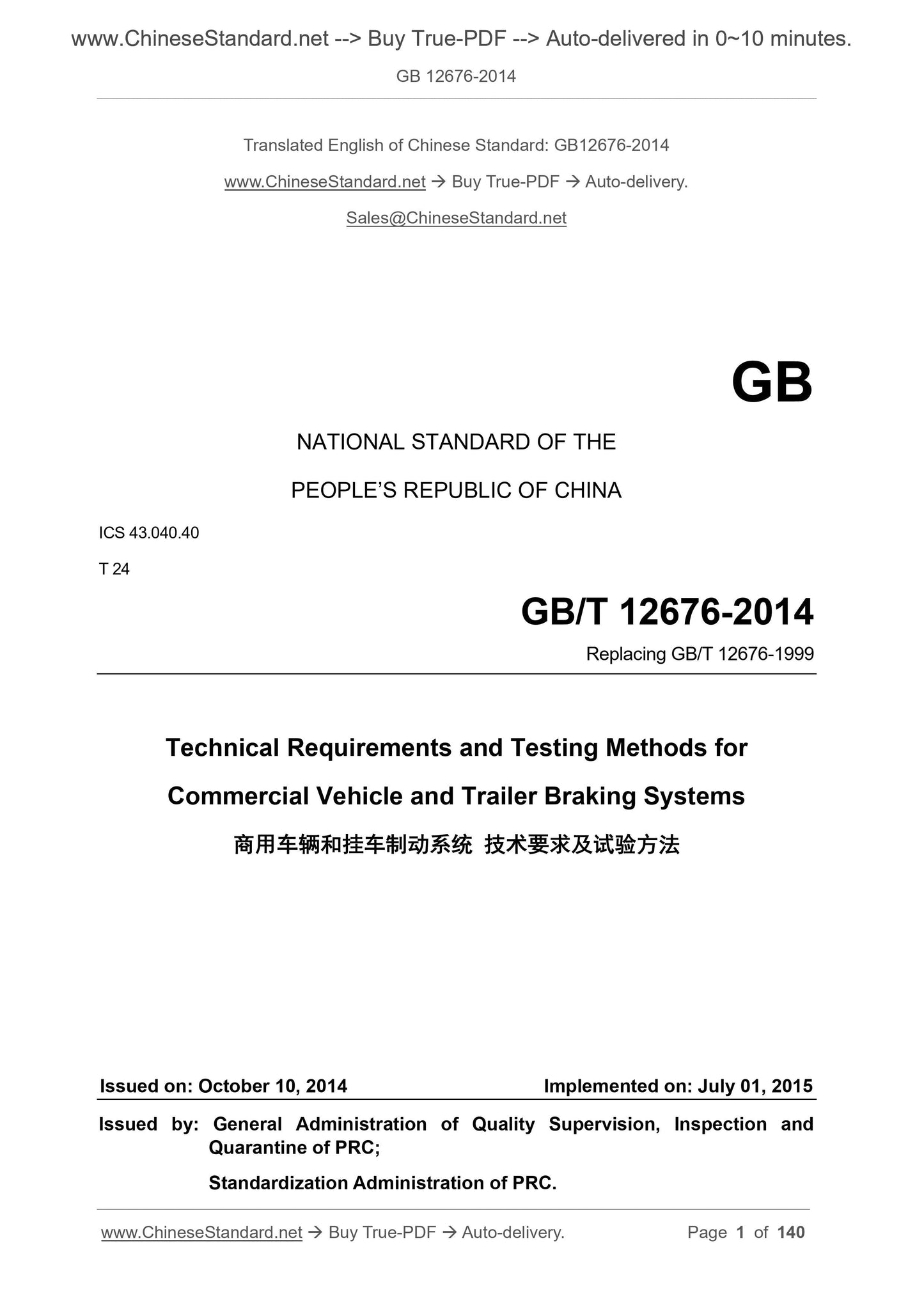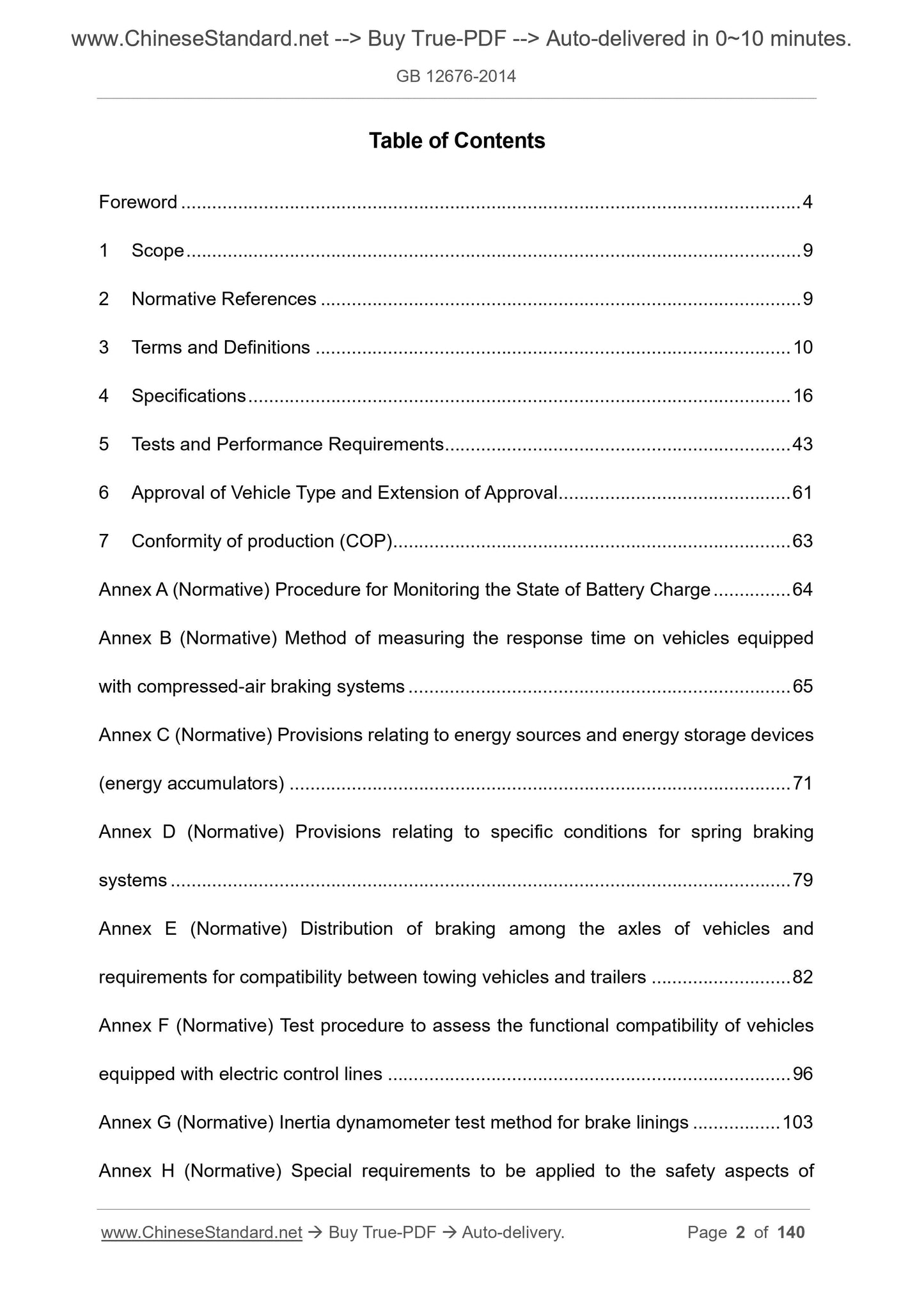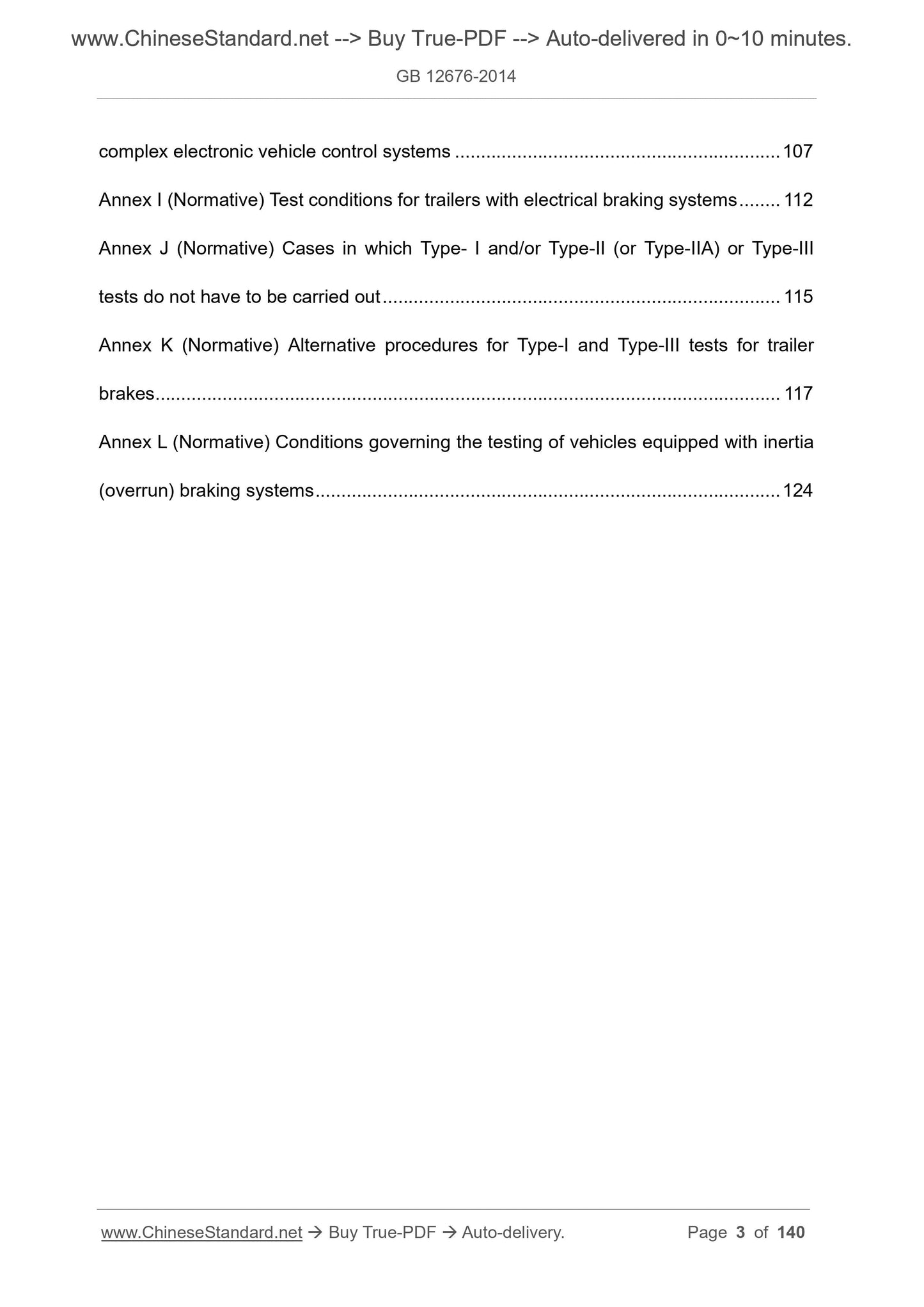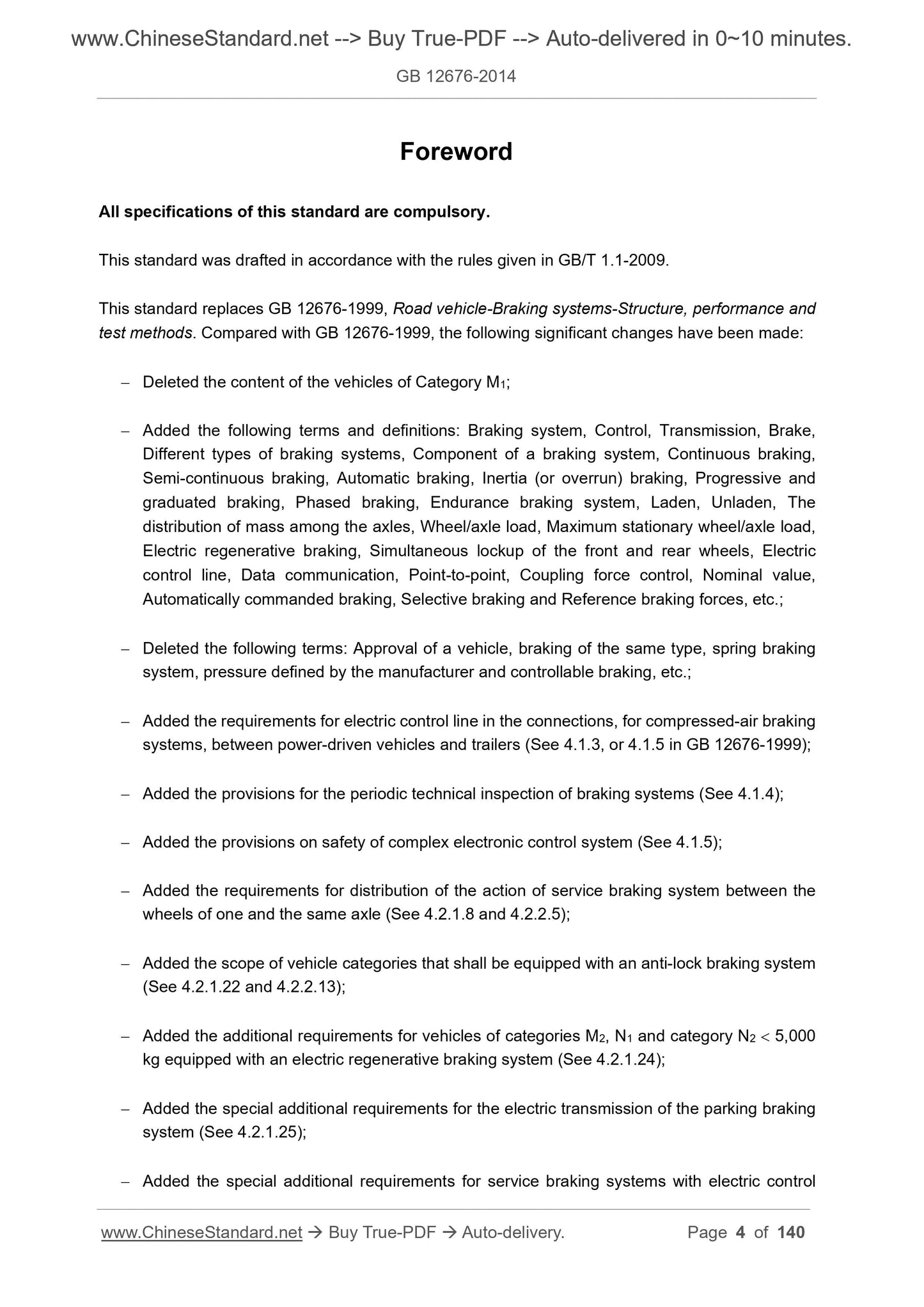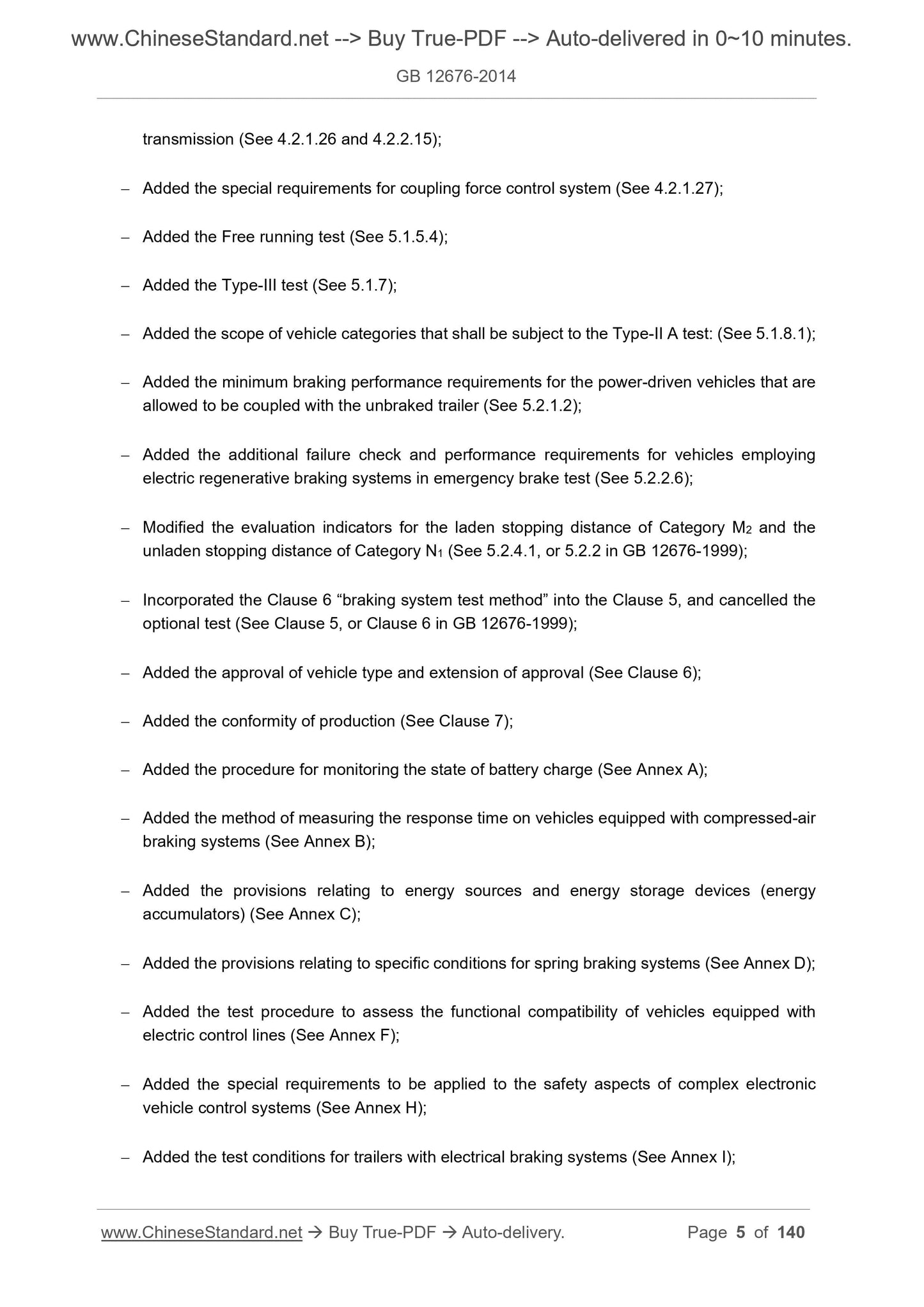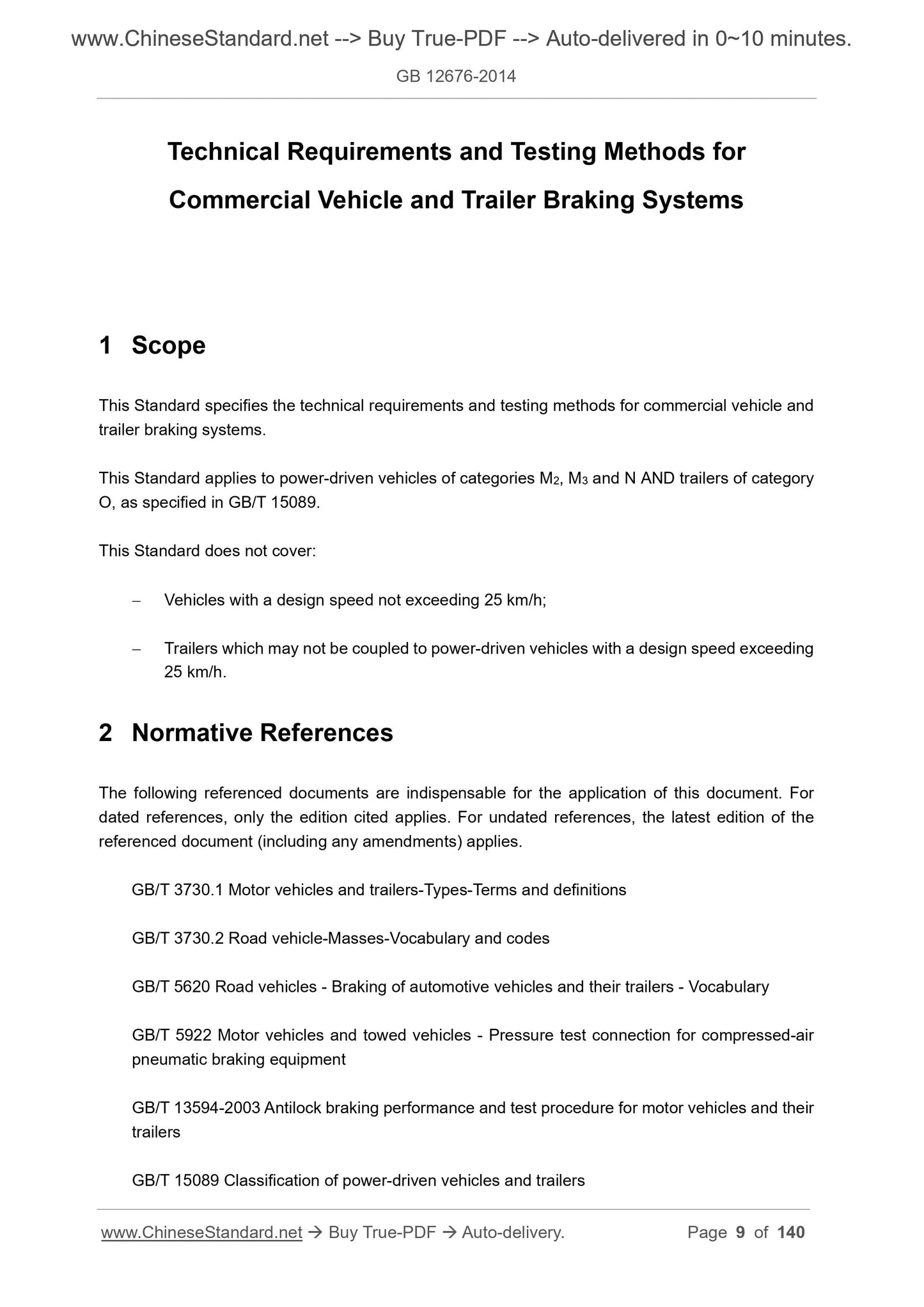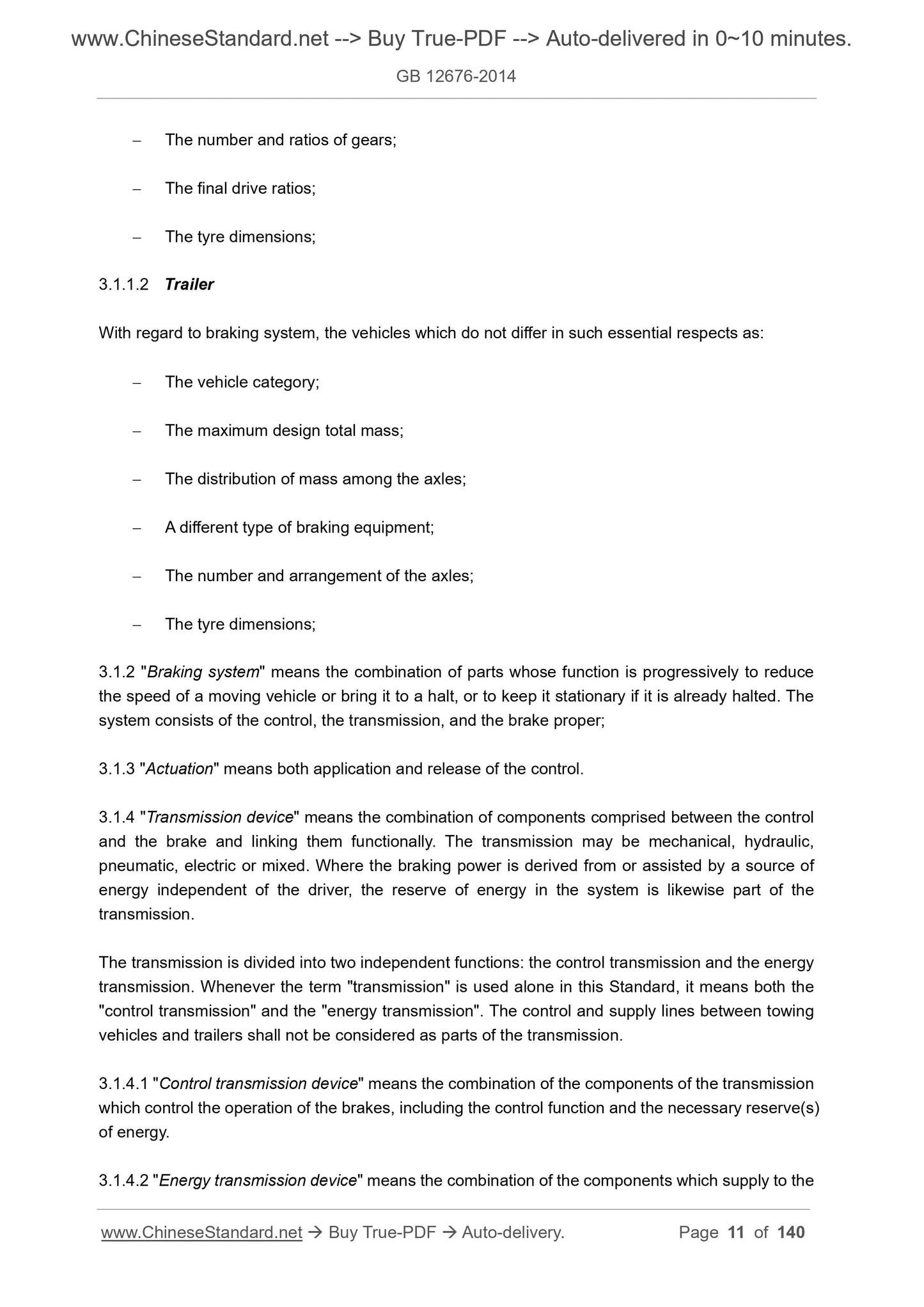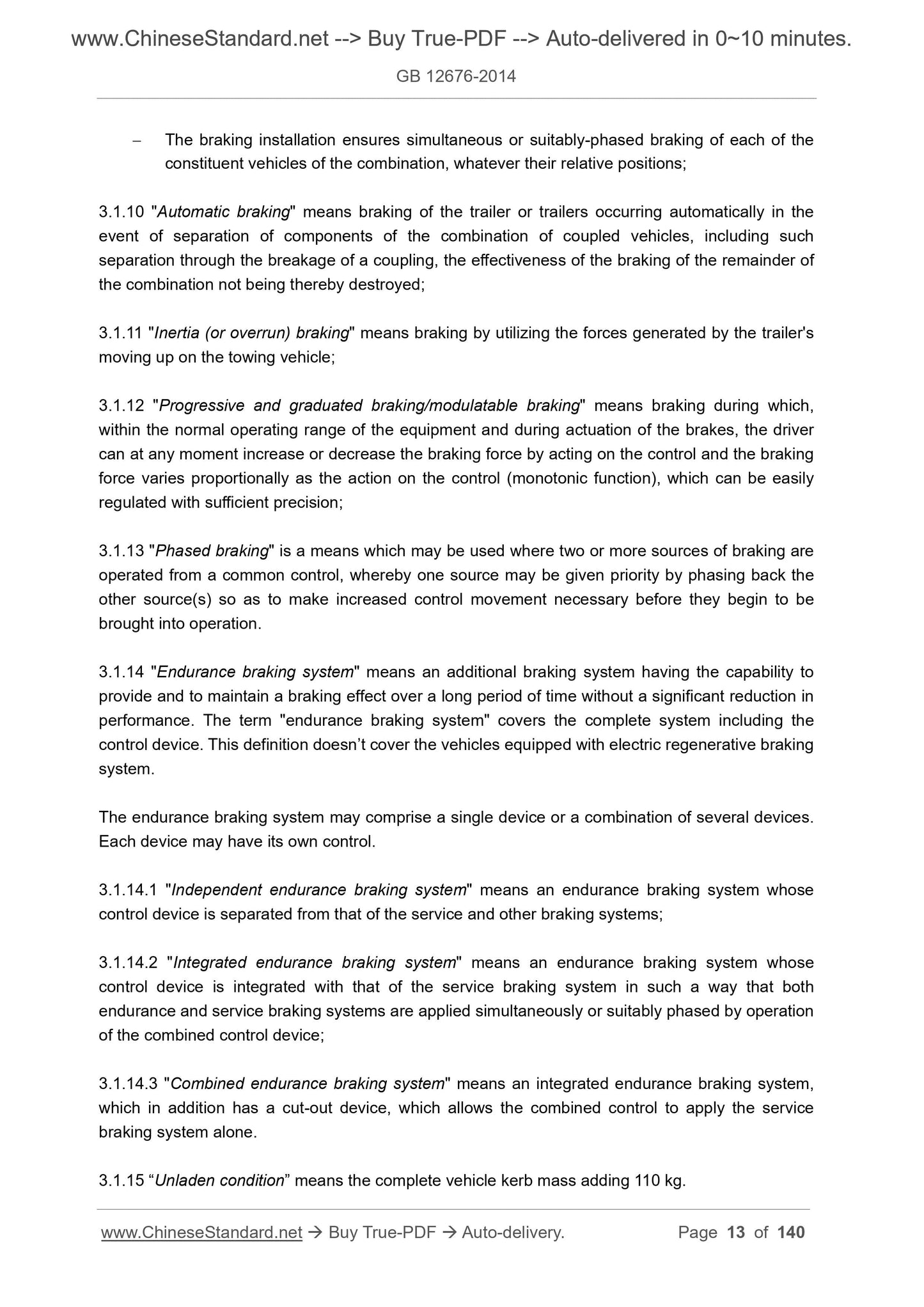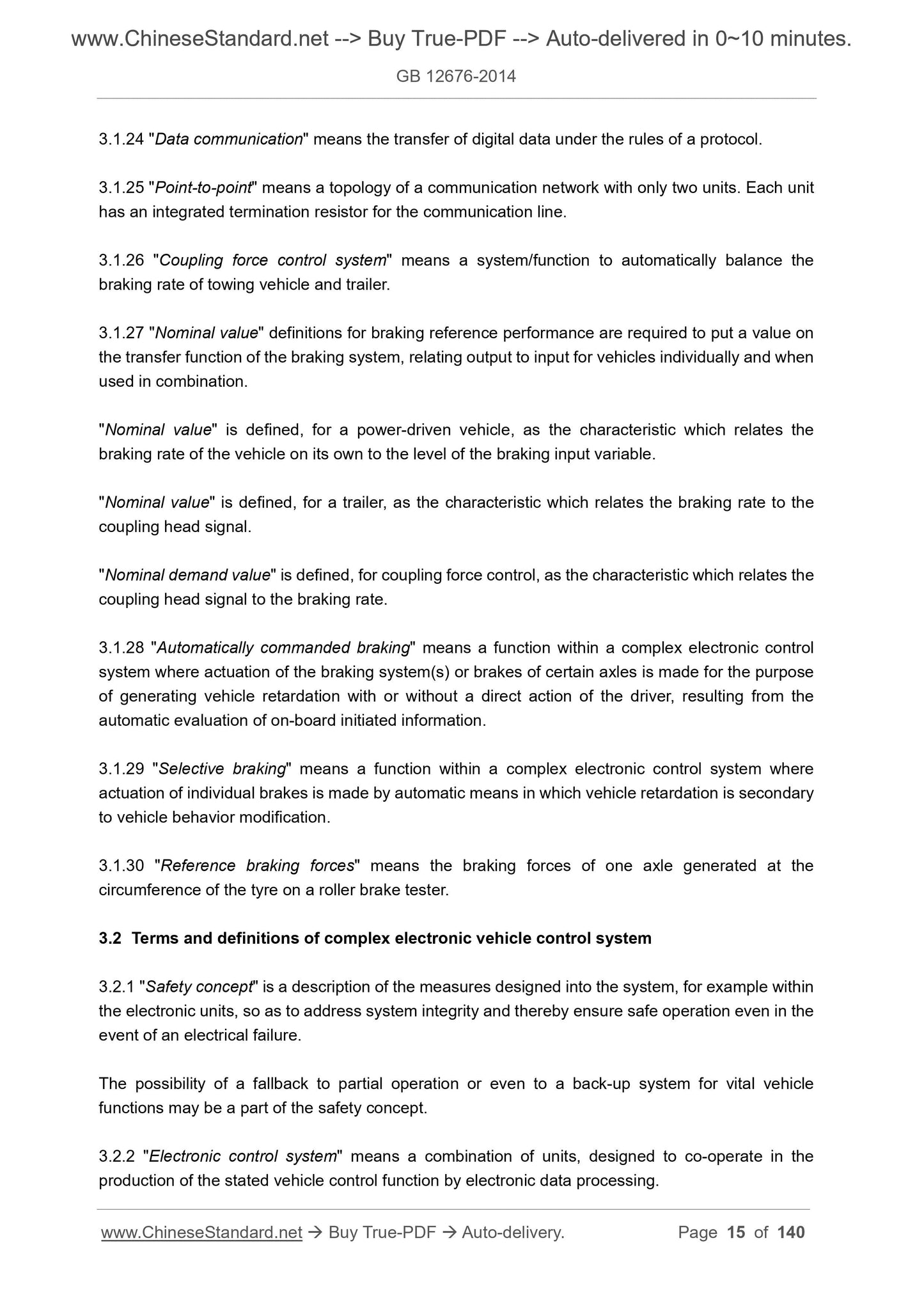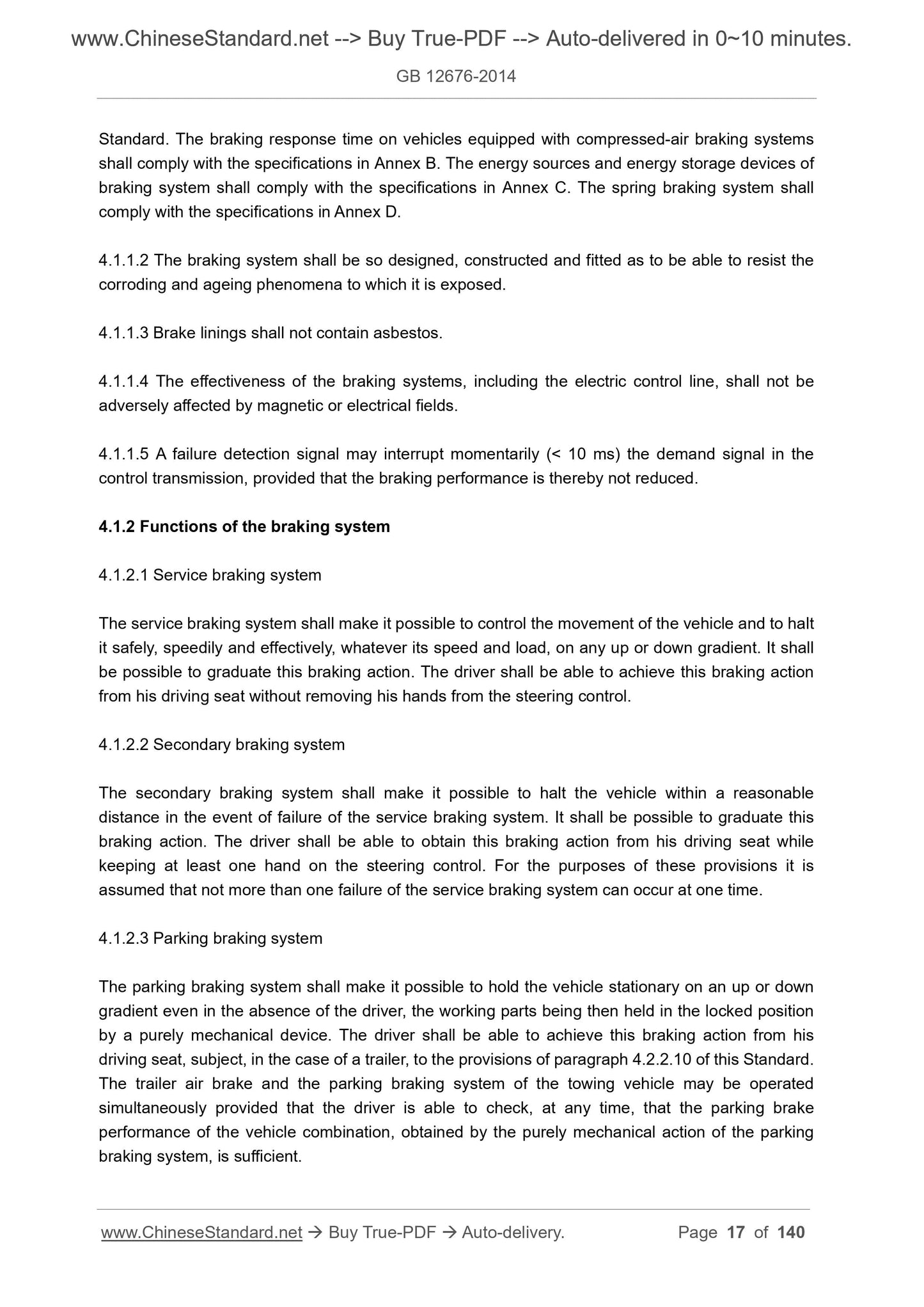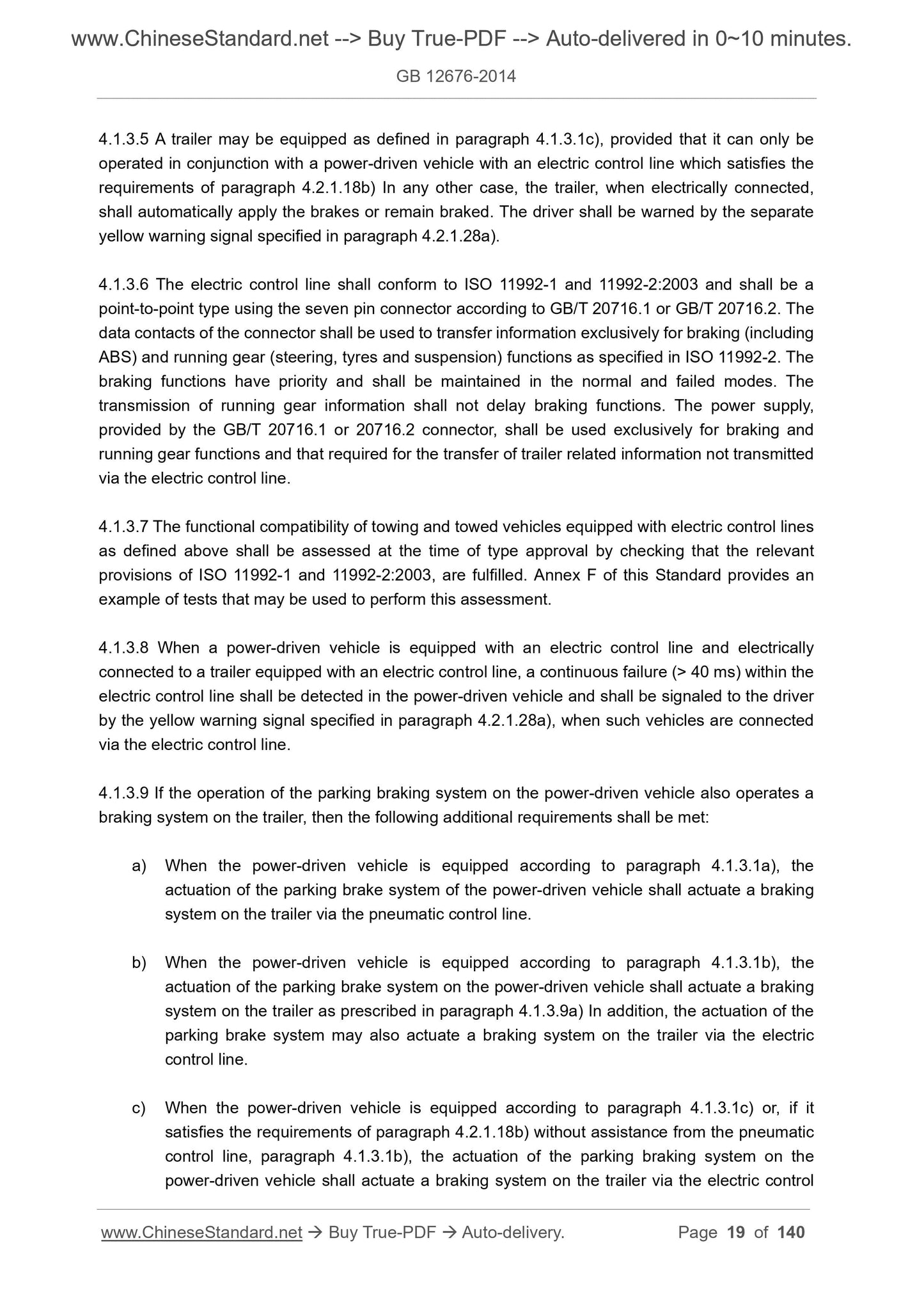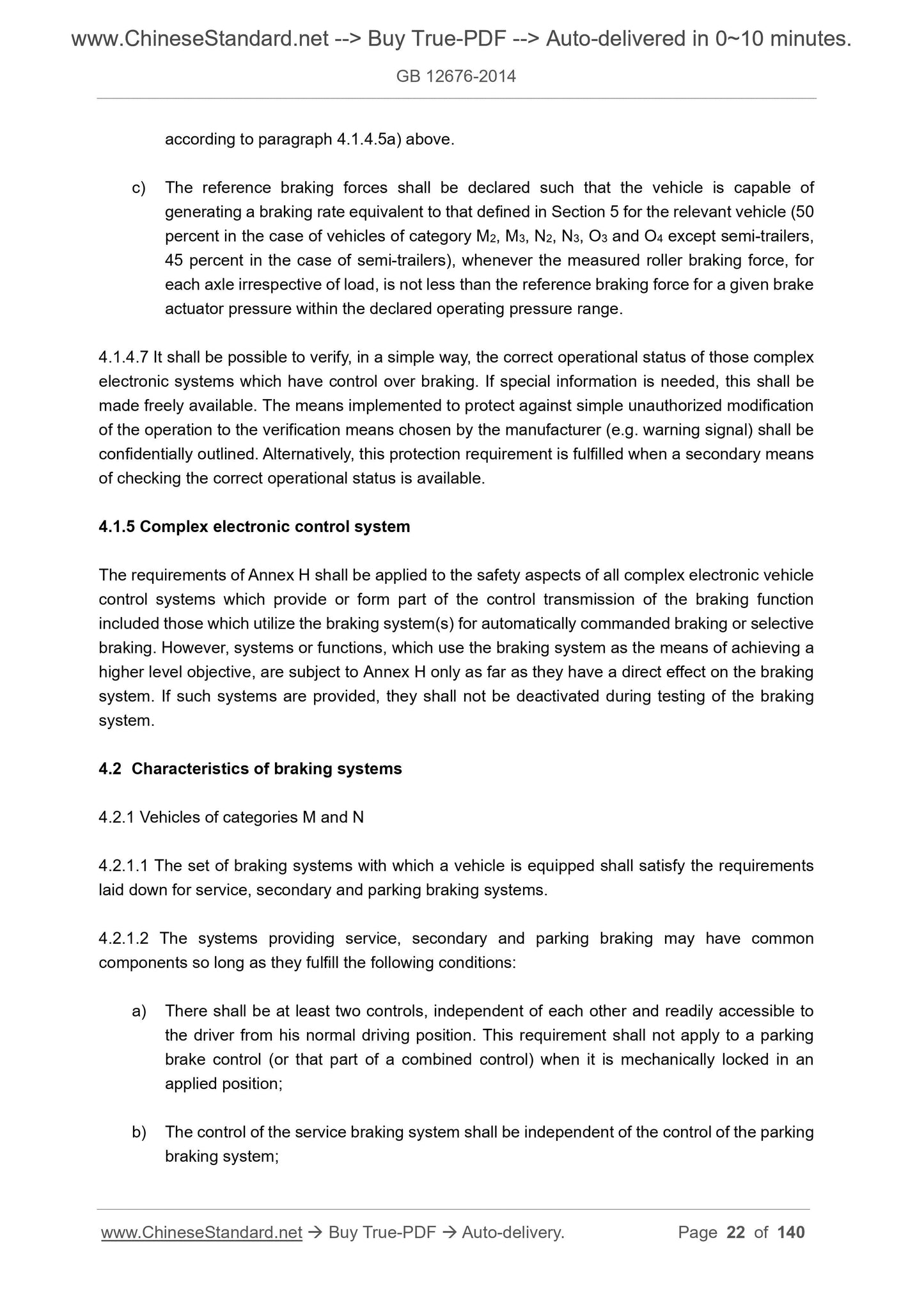1
/
de
12
PayPal, credit cards. Download editable-PDF & invoice in 1 second!
GB 12676-2014 English PDF (GB12676-2014)
GB 12676-2014 English PDF (GB12676-2014)
Prix habituel
$305.00 USD
Prix habituel
Prix promotionnel
$305.00 USD
Prix unitaire
/
par
Frais d'expédition calculés à l'étape de paiement.
Impossible de charger la disponibilité du service de retrait
Delivery: 3 seconds. Download true-PDF + Invoice.
Get QUOTATION in 1-minute: Click GB 12676-2014
Historical versions: GB 12676-2014
Preview True-PDF (Reload/Scroll if blank)
GB 12676-2014: Road vehicle -- Braking systems -- Structure, performance and test methods
GB 12676-2014
NATIONAL STANDARD OF THE
PEOPLE’S REPUBLIC OF CHINA
ICS 43.040.40
T 24
GB/T 12676-2014
Replacing GB/T 12676-1999
Technical Requirements and Testing Methods for
Commercial Vehicle and Trailer Braking Systems
ISSUED ON: OCTOBER 10, 2014
IMPLEMENTED ON: JULY 01, 2015
Issued by: General Administration of Quality Supervision, Inspection and
Quarantine of PRC;
Standardization Administration of PRC.
Table of Contents
Foreword ... 4
1 Scope ... 9
2 Normative References ... 9
3 Terms and Definitions ... 10
4 Specifications ... 16
5 Tests and Performance Requirements ... 43
6 Approval of Vehicle Type and Extension of Approval ... 61
7 Conformity of production (COP) ... 63
Annex A (Normative) Procedure for Monitoring the State of Battery Charge ... 64
Annex B (Normative) Method of measuring the response time on vehicles equipped
with compressed-air braking systems ... 65
Annex C (Normative) Provisions relating to energy sources and energy storage devices
(energy accumulators) ... 71
Annex D (Normative) Provisions relating to specific conditions for spring braking
systems ... 79
Annex E (Normative) Distribution of braking among the axles of vehicles and
requirements for compatibility between towing vehicles and trailers ... 82
Annex F (Normative) Test procedure to assess the functional compatibility of vehicles
equipped with electric control lines ... 96
Annex G (Normative) Inertia dynamometer test method for brake linings ... 103
Annex H (Normative) Special requirements to be applied to the safety aspects of
complex electronic vehicle control systems ... 107
Annex I (Normative) Test conditions for trailers with electrical braking systems ... 112
Annex J (Normative) Cases in which Type- I and/or Type-II (or Type-IIA) or Type-III
tests do not have to be carried out ... 115
Annex K (Normative) Alternative procedures for Type-I and Type-III tests for trailer
brakes ... 117
Annex L (Normative) Conditions governing the testing of vehicles equipped with inertia
(overrun) braking systems ... 124
Foreword
All specifications of this standard are compulsory.
This standard was drafted in accordance with the rules given in GB/T 1.1-2009.
This standard replaces GB 12676-1999, Road vehicle-Braking systems-Structure, performance and
test methods. Compared with GB 12676-1999, the following significant changes have been made:
Deleted the content of the vehicles of Category M1;
Added the following terms and definitions: Braking system, Control, Transmission, Brake,
Different types of braking systems, Component of a braking system, Continuous braking,
Semi-continuous braking, Automatic braking, Inertia (or overrun) braking, Progressive and
graduated braking, Phased braking, Endurance braking system, Laden, Unladen, The
distribution of mass among the axles, Wheel/axle load, Maximum stationary wheel/axle load,
Electric regenerative braking, Simultaneous lockup of the front and rear wheels, Electric
control line, Data communication, Point-to-point, Coupling force control, Nominal value,
Automatically commanded braking, Selective braking and Reference braking forces, etc.;
Deleted the following terms: Approval of a vehicle, braking of the same type, spring braking
system, pressure defined by the manufacturer and controllable braking, etc.;
Added the requirements for electric control line in the connections, for compressed-air braking
systems, between power-driven vehicles and trailers (See 4.1.3, or 4.1.5 in GB 12676-1999);
Added the provisions for the periodic technical inspection of braking systems (See 4.1.4);
Added the provisions on safety of complex electronic control system (See 4.1.5);
Added the requirements for distribution of the action of service braking system between the
wheels of one and the same axle (See 4.2.1.8 and 4.2.2.5);
Added the scope of vehicle categories that shall be equipped with an anti-lock braking system
(See 4.2.1.22 and 4.2.2.13);
Added the additional requirements for vehicles of categories M2, N1 and category N2 5,000
kg equipped with an electric regenerative braking system (See 4.2.1.24);
Added the special additional requirements for the electric transmission of the parking braking
system (See 4.2.1.25);
Added the special additional requirements for service braking systems with electric control
transmission (See 4.2.1.26 and 4.2.2.15);
Added the special requirements for coupling force control system (See 4.2.1.27);
Added the Free running test (See 5.1.5.4);
Added the Type-III test (See 5.1.7);
Added the scope of vehicle categories that shall be subject to the Type-II A test: (See 5.1.8.1);
Added the minimum braking performance requirements for the power-driven vehicles that are
allowed to be coupled with the unbraked trailer (See 5.2.1.2);
Added the additional failure check and performance requirements for vehicles employing
electric regenerative braking systems in emergency brake test (See 5.2.2.6);
Modified the evaluation indicators for the laden stopping distance of Category M2 and the
unladen stopping distance of Category N1 (See 5.2.4.1, or 5.2.2 in GB 12676-1999);
Incorporated the Clause 6 “braking system test method” into the Clause 5, and cancelled the
optional test (See Clause 5, or Clause 6 in GB 12676-1999);
Added the approval of vehicle type and extension of approval (See Clause 6);
Added the conformity of production (See Clause 7);
Added the procedure for monitoring the state of battery charge (See Annex A);
Added the method of measuring the response time on vehicles equipped with compressed-air
braking systems (See Annex B);
Added the provisions relating to energy sources and energy storage devices (energy
accumulators) (See Annex C);
Added the provisions relating to specific conditions for spring braking systems (See Annex D);
Added the test procedure to assess the functional compatibility of vehicles equipped with
electric control lines (See Annex F);
Added the special requirements to be applied to the safety aspects of complex electronic
vehicle control systems (See Annex H);
Added the test conditions for trailers with electrical braking systems (See Annex I);
Technical Requirements and Testing Methods for
Commercial Vehicle and Trailer Braking Systems
1 Scope
This Standard specifies the technical requirements and testing methods for commercial vehicle and
trailer braking systems.
This Standard applies to power-driven vehicles of categories M2, M3 and N AND trailers of category
O, as specified in GB/T 15089.
This Standard does not cover:
Vehicles with a design speed not exceeding 25 km/h;
Trailers which may not be coupled to power-driven vehicles with a design speed exceeding
25 km/h.
2 Normative References
The following referenced documents are indispensable for the application of this document. For
dated references, only the edition cited applies. For undated references, the latest edition of the
referenced document (including any amendments) applies.
GB/T 3730.1 Motor vehicles and trailers-Types-Terms and definitions
GB/T 3730.2 Road vehicle-Masses-Vocabulary and codes
GB/T 5620 Road vehicles - Braking of automotive vehicles and their trailers - Vocabulary
GB/T 5922 Motor vehicles and towed vehicles - Pressure test connection for compressed-air
pneumatic braking equipment
GB/T 13594-2003 Antilock braking performance and test procedure for motor ...
Get QUOTATION in 1-minute: Click GB 12676-2014
Historical versions: GB 12676-2014
Preview True-PDF (Reload/Scroll if blank)
GB 12676-2014: Road vehicle -- Braking systems -- Structure, performance and test methods
GB 12676-2014
NATIONAL STANDARD OF THE
PEOPLE’S REPUBLIC OF CHINA
ICS 43.040.40
T 24
GB/T 12676-2014
Replacing GB/T 12676-1999
Technical Requirements and Testing Methods for
Commercial Vehicle and Trailer Braking Systems
ISSUED ON: OCTOBER 10, 2014
IMPLEMENTED ON: JULY 01, 2015
Issued by: General Administration of Quality Supervision, Inspection and
Quarantine of PRC;
Standardization Administration of PRC.
Table of Contents
Foreword ... 4
1 Scope ... 9
2 Normative References ... 9
3 Terms and Definitions ... 10
4 Specifications ... 16
5 Tests and Performance Requirements ... 43
6 Approval of Vehicle Type and Extension of Approval ... 61
7 Conformity of production (COP) ... 63
Annex A (Normative) Procedure for Monitoring the State of Battery Charge ... 64
Annex B (Normative) Method of measuring the response time on vehicles equipped
with compressed-air braking systems ... 65
Annex C (Normative) Provisions relating to energy sources and energy storage devices
(energy accumulators) ... 71
Annex D (Normative) Provisions relating to specific conditions for spring braking
systems ... 79
Annex E (Normative) Distribution of braking among the axles of vehicles and
requirements for compatibility between towing vehicles and trailers ... 82
Annex F (Normative) Test procedure to assess the functional compatibility of vehicles
equipped with electric control lines ... 96
Annex G (Normative) Inertia dynamometer test method for brake linings ... 103
Annex H (Normative) Special requirements to be applied to the safety aspects of
complex electronic vehicle control systems ... 107
Annex I (Normative) Test conditions for trailers with electrical braking systems ... 112
Annex J (Normative) Cases in which Type- I and/or Type-II (or Type-IIA) or Type-III
tests do not have to be carried out ... 115
Annex K (Normative) Alternative procedures for Type-I and Type-III tests for trailer
brakes ... 117
Annex L (Normative) Conditions governing the testing of vehicles equipped with inertia
(overrun) braking systems ... 124
Foreword
All specifications of this standard are compulsory.
This standard was drafted in accordance with the rules given in GB/T 1.1-2009.
This standard replaces GB 12676-1999, Road vehicle-Braking systems-Structure, performance and
test methods. Compared with GB 12676-1999, the following significant changes have been made:
Deleted the content of the vehicles of Category M1;
Added the following terms and definitions: Braking system, Control, Transmission, Brake,
Different types of braking systems, Component of a braking system, Continuous braking,
Semi-continuous braking, Automatic braking, Inertia (or overrun) braking, Progressive and
graduated braking, Phased braking, Endurance braking system, Laden, Unladen, The
distribution of mass among the axles, Wheel/axle load, Maximum stationary wheel/axle load,
Electric regenerative braking, Simultaneous lockup of the front and rear wheels, Electric
control line, Data communication, Point-to-point, Coupling force control, Nominal value,
Automatically commanded braking, Selective braking and Reference braking forces, etc.;
Deleted the following terms: Approval of a vehicle, braking of the same type, spring braking
system, pressure defined by the manufacturer and controllable braking, etc.;
Added the requirements for electric control line in the connections, for compressed-air braking
systems, between power-driven vehicles and trailers (See 4.1.3, or 4.1.5 in GB 12676-1999);
Added the provisions for the periodic technical inspection of braking systems (See 4.1.4);
Added the provisions on safety of complex electronic control system (See 4.1.5);
Added the requirements for distribution of the action of service braking system between the
wheels of one and the same axle (See 4.2.1.8 and 4.2.2.5);
Added the scope of vehicle categories that shall be equipped with an anti-lock braking system
(See 4.2.1.22 and 4.2.2.13);
Added the additional requirements for vehicles of categories M2, N1 and category N2 5,000
kg equipped with an electric regenerative braking system (See 4.2.1.24);
Added the special additional requirements for the electric transmission of the parking braking
system (See 4.2.1.25);
Added the special additional requirements for service braking systems with electric control
transmission (See 4.2.1.26 and 4.2.2.15);
Added the special requirements for coupling force control system (See 4.2.1.27);
Added the Free running test (See 5.1.5.4);
Added the Type-III test (See 5.1.7);
Added the scope of vehicle categories that shall be subject to the Type-II A test: (See 5.1.8.1);
Added the minimum braking performance requirements for the power-driven vehicles that are
allowed to be coupled with the unbraked trailer (See 5.2.1.2);
Added the additional failure check and performance requirements for vehicles employing
electric regenerative braking systems in emergency brake test (See 5.2.2.6);
Modified the evaluation indicators for the laden stopping distance of Category M2 and the
unladen stopping distance of Category N1 (See 5.2.4.1, or 5.2.2 in GB 12676-1999);
Incorporated the Clause 6 “braking system test method” into the Clause 5, and cancelled the
optional test (See Clause 5, or Clause 6 in GB 12676-1999);
Added the approval of vehicle type and extension of approval (See Clause 6);
Added the conformity of production (See Clause 7);
Added the procedure for monitoring the state of battery charge (See Annex A);
Added the method of measuring the response time on vehicles equipped with compressed-air
braking systems (See Annex B);
Added the provisions relating to energy sources and energy storage devices (energy
accumulators) (See Annex C);
Added the provisions relating to specific conditions for spring braking systems (See Annex D);
Added the test procedure to assess the functional compatibility of vehicles equipped with
electric control lines (See Annex F);
Added the special requirements to be applied to the safety aspects of complex electronic
vehicle control systems (See Annex H);
Added the test conditions for trailers with electrical braking systems (See Annex I);
Technical Requirements and Testing Methods for
Commercial Vehicle and Trailer Braking Systems
1 Scope
This Standard specifies the technical requirements and testing methods for commercial vehicle and
trailer braking systems.
This Standard applies to power-driven vehicles of categories M2, M3 and N AND trailers of category
O, as specified in GB/T 15089.
This Standard does not cover:
Vehicles with a design speed not exceeding 25 km/h;
Trailers which may not be coupled to power-driven vehicles with a design speed exceeding
25 km/h.
2 Normative References
The following referenced documents are indispensable for the application of this document. For
dated references, only the edition cited applies. For undated references, the latest edition of the
referenced document (including any amendments) applies.
GB/T 3730.1 Motor vehicles and trailers-Types-Terms and definitions
GB/T 3730.2 Road vehicle-Masses-Vocabulary and codes
GB/T 5620 Road vehicles - Braking of automotive vehicles and their trailers - Vocabulary
GB/T 5922 Motor vehicles and towed vehicles - Pressure test connection for compressed-air
pneumatic braking equipment
GB/T 13594-2003 Antilock braking performance and test procedure for motor ...
Share
